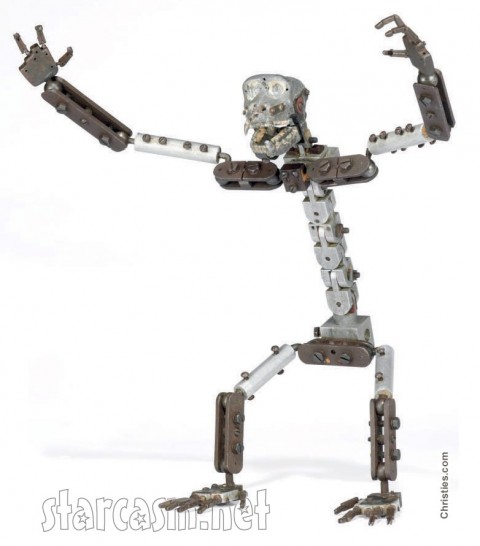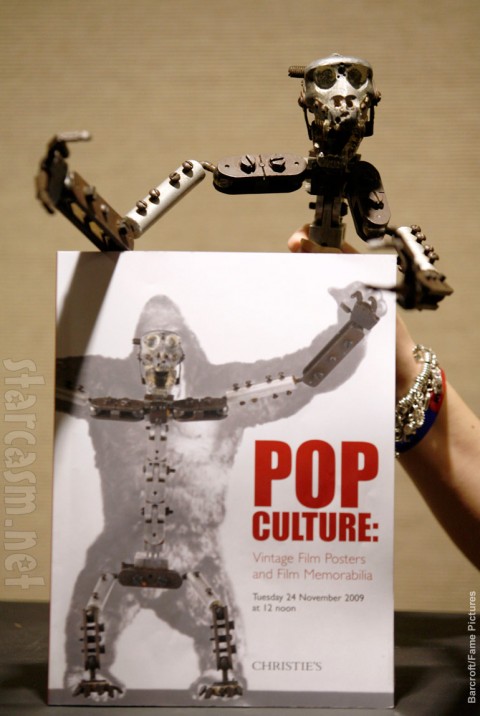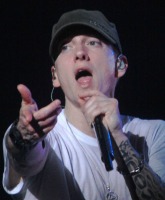PHOTOS Original 1933 King Kong sculpture to be auctioned by Christie’s

Do you have a hard-to-shop-for movie buff on your Christmas shopping list? Do you have $250,000 to spend? Then Christie’s has exactly what you’re looking for!
As part of their Vintage Film Posters and Film Memorabilia auction the London-based auction house is offering the Willis O’Brien-designed King Kong armature skeleton used for the famous climactic Empire State Building scenes from the 1933 stop-motion classic.

The Vintage Film Posters and Film Memorabilia auction will be held on November 24, 2009. There are all sorts of details about the armature model on Christies.com, as would be expected for an item estimated to go for somewhere between $167,900 and $251,850! Here is the overview:
An exceptionally rare Armature/Skeleton designed by Willis O’Brien for the largest of the miniature models of the gorilla King Kong used in the Empire State building sequences in the climax of the 1933 RKO masterpiece of stop-motion animation King Kong; the highly detailed armature manufactured in the RKO Studios’ Miniature Department Workshops from steel and various alloys, comprising a sophisticated system of interlocking ball and socket joints, bolts and screws which combine to give a remarkable degree of articulation in even the tiniest of joints; the structure is made from two blocks, one at the ‘neck’ and one at the ‘hips’ connected by a hinged ‘spine’ to which ball-jointed shoulders and hips are screwed; the arms comprise separate upper and lower sections connected by ball joints, the hands, similarly connected by a ball joint are shaped-blocks fitted with jointed fingers, (the right hand missing the last two fingers, the left hand missing the third and last finger); the legs similarly comprise an upper and lower section connected at the ‘knee’ by a ball joint, the feet, connected by an ‘ankle’ ball joint are made from a separate block to which five jointed toes are fitted; the life-like skull moulded in two sections connected by a highly effective hinged ‘jaw’; the armature – 22in. (55.8cm) high.

Accompanied by a fascinating selection of rare photographs, stills and documents, some previously unpublished (the majority printed recently) concerning the provenance of this armature, the design and manufacture of the miniature models at RKO Studios in the 1930s; and the history of the production of this groundbreaking film King Kong, 1933, including: a signed letter from Eugene L. Hilchey concerning the provenance; a photocopy of Willis O’Brien’s original circa 1932 blueprint design of the King Kong armature [without the skull] entitled SKELETON FULL SIZE – PLATE 5, given to Hilchey by O’Brien in 1960s, Sight — 23×24.5in. (58.5×62.3cm.); two previously unpublished photographs of a miniature model of King Kong standing on top of a model of the Empire State building apparently taken in 1932 during the shooting of the film (printed recently), both — 10x8in. (25.4×20.3cm.); a rare set of six previously unpublished photographs of the RKO Miniature Department taken in circa 1932 (printed recently), majority — 8x10in. (20.3×25.4cm.); three previously unpublished photographs of a King Kong miniature model, taken by Eugene Hilchey when visiting the Miniature Department at RKO Studios in 1949 (printed recently), each — 8x10in. (20.3×25.4cm.); and related material(a lot)For full list see footnote.
Click thumbnails to see larger images in the gallery:

Is the actual King Kong skeletal armature a little bit out of your price range? You can still grab a little bit of King Kong history by purchasing these original costume designs for Fay Ray as Ann Darrow by Natalie Visart. They are projected to go for a final bid in the $16,790 – $25,185 range. Here’s some info about the designs – read the complete description and provenance at Christies.com:
This costume design for Fay Wray as Ann Darrow in the famous screen test/’Scream’ scene on the boat to Skull Island in King Kong, 1933 is significant on several counts. Although historians generally agree that it is the only costume specifically ‘designed’ for the film, the others being hired from Western Costume, it has, until now, been wrongly attributed to Walter Plunkett, who became head of RKO wardrobe department in September 1932 three months after shooting of the film’s live action scenes had begun. Bison Archives’ discovery of Visart’s design, signed by the artist and approved by the director Merian C. Cooper, has therefore set this record straight.
The fact that this scene was the only one in the whole film to merit a customized design indicates its importance. Cooper used it to firmly establish the film’s ‘Beauty and the Beast’ theme. Executive producer David O’Selznick had apparently wanted to cut the scene from the film, but Cooper stood firm. Cooper knew that by dressing Wray in the medieval-style costume of a fairy princess, he could emphasize her innocence and illustrate the freshness of her beauty. After all, for most of the subsequent film Wray as Ann was to appear dishevelled, distraught and filthy having been dragged through the jungle or forced to scale the skyline of New York. …
Subscribe to Starcasm by Email










